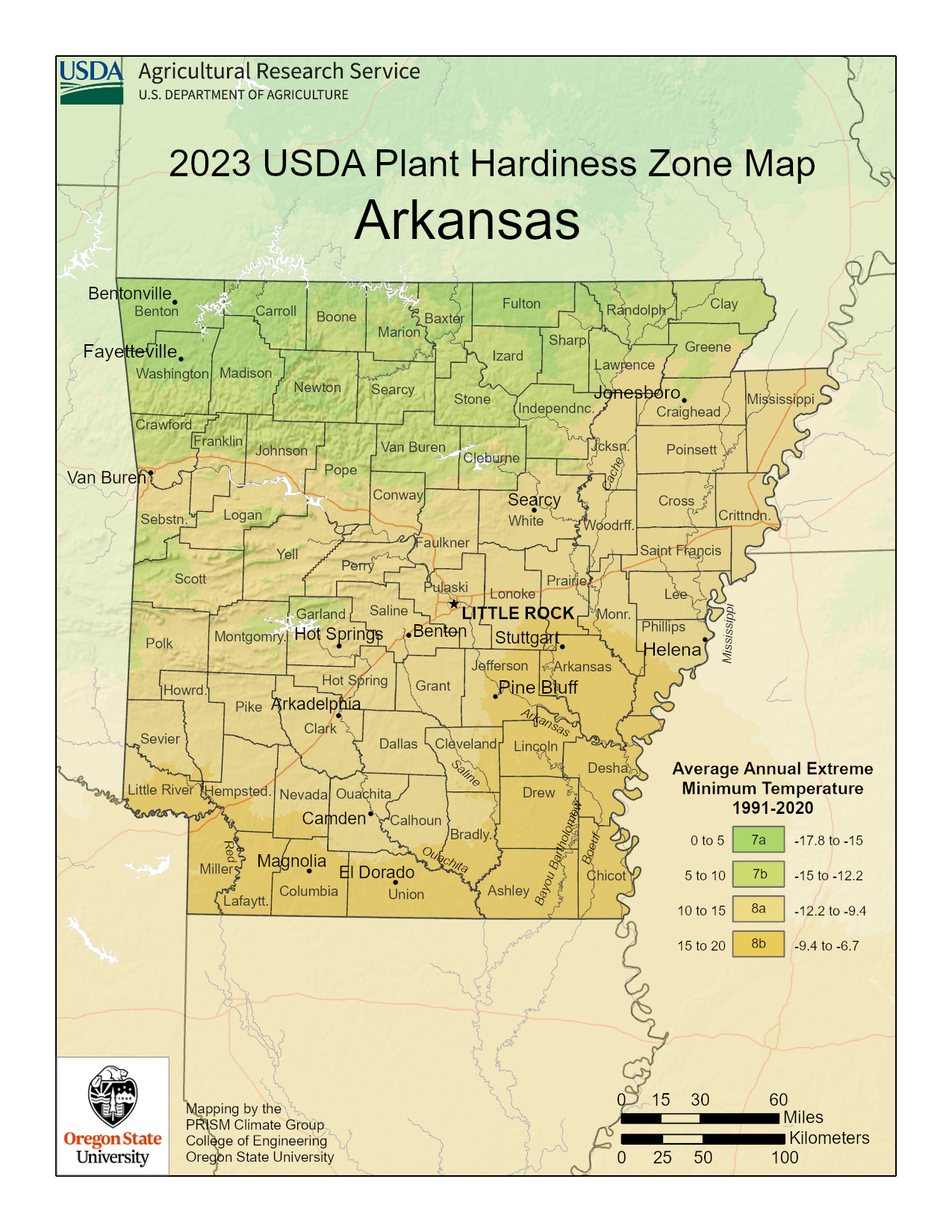2023 Plant Hardiness Zone Map
Contact
University of Arkansas System Division of Agriculture
Cooperative Extension Service
2301 S. University Ave.
Little Rock, AR 72204

2023 Plant Hardiness Zone Map
In these contentious times, everyone knows small talk involving politics or religion is to be avoided. Weather, once considered a safe conversation starter, is also becoming controversial if you stray far from “Looks like rain” or “Sure has been hot.” But weather is important, especially to anyone involved in agriculture or gardening. The U.S. Department of Agriculture’s Ag Research Service and Oregon State University’s PRISM Climate Group have just released an update to the Plant Hardiness Zone Map it has been refining since the 1960s.
Plant hardiness zone maps were first used by Alfred Rheder in his Manual of Cultivated Trees and Shrubs in 1927. Rheder was part of the Arnold Arboretum in Boston and worked with Donald Wyman, who wrote what became the standard texts on hardy woody plants for American gardens. The Arnold Maps Wyman used were periodically updated until 1971, but the nursery industry finally adopted USDA’s map as the standard for defining the northern limits of where a plant would grow in the United States.
The 2023 map makers are quick to point out that their map is attempting to define weather conditions – specifically as it relates to average minimum temperature for a specific region – not climate change. The map is based on a thirty-year data set (1991 – 2020) looking at average minimum temperature from 13,412 reporting stations around the nation. The PRISM program then overlays these temperature records onto a topographic map divided into about one-half square mile grids and adjusts for elevation, proximity to large bodies of water and other features that could modify the recorded temperature. Climate change, or so say the map mappers, rely on 50- or 100-year temperature averages to see long-term trends.
But the map does show things are warming up. I first noticed the warmer weather in the 1990s after tracking the blooming dates for forsythia and tulips. After watching for about 25 years, the forsythia bloomed an average of about five days earlier and tulips closer to 10. The 2023 map shows that the southern half of the nation has shifted about half a hardiness zone warmer. In previous maps the northern parts of Arkansas marked the boundary between zones 6 and 7; in the new map this boundary has shifted about 100 miles north into the Missouri Ozarks.
The last four winters here in the new banana belt are ironic and also illustrate the point that the map reflects weather, not climate. Even though the map shows northern Arkansas is firmly ensconced in zone 7, crapemyrtles have frozen back twice since 2019. I started planting the Fauriei hybrid crapemyrtles in a trial area at the UofA in Fayetteville in 1992 after hearing they were supposed to be a bit more winter hardy than the older Indica types. If there is a difference in hardiness between the two types, it is a minor one, but the crapemyrtles did eventually grow to tree size.
But crapemyrtles still periodically froze back, such as the winter of 2011 when the mid-winter low dropped to -18 degrees F. Many things affect winter kill when it comes to predicting winter hardiness besides minimum killing temperature which is around 0 degrees F for crapemyrtle. Experts have gotten pretty good at predicting how much cold a species will take if it is completely dormant, not suffering drought and not in a problematic site in a landscape where it stays colder or warmer than the surrounding landscape. But an early freeze before a plant has properly hardened off for the winter or early season warming before winter is really over causes havoc with otherwise reliably hardy plants.
The climate scientists tell us that 2023 was the hottest year on record since worldwide data first became available about 150 years ago. The new zone map reflects this trend towards a warming garden environment but gardeners need to remember one of the other characteristics of weather undergoing climate change. Namely, weather patterns will be more unpredictable with high and low temperature extremes becoming more common. This also applies to the amount of rain we receive and the severity of storms. So, stay tuned. The weather is always changing.
